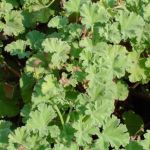| Common Name: |
Nutmeg Geranium |
| Botanical Name: |
Pelargonium Fragrans Group syn. P. 'Fragrans', P. x fragrans |
| Genus: |
Pelargonium |
| Family: |
Geraniaceae |
| Location: |
S Africa |
| Cultivation: |
Well-drained, neutral to alkaline soil in sun. Pelargonium crispum, P. odoratissimum, and P. tomentosum tolerate partial shade. Plants may be cut back in early spring. If grown outdoors in cool climates, they may also be cut back before bringing in for the winter. Leafhoppers, aphids, spider mites, and whitefly may attack plants under cover. |
| Propagation: |
By softwood cuttings in spring, late summer, or early autumn. |
| Harvest: |
Plants are cut in late summer and distilled for oil. Leaves are picked as required. |
| Height: |
30-40cm (12-16in) |
| :Width |
30-40cm (12-16in) |
| Variations: |
Creamy Nutmeg
Has a low habit and small leaves with broad cream margins. |
Fragrans Variegatum
syn. Snowy Nutmeg
Has cream to chartreuse variegation. |
Old spice
Has a compact habit and crinkled leaves. |
|
| Hardiness: |
Min. 2°C (36°F) |
| Parts Used: |
Leaves |
| Properties: |
An aromatic herb with a spicy, pine-like scent.. |
| Medicinal Uses: |
Externally as a rub for aching feet or legs (fresh leaves). |
| Culinary Uses: |
Leaves give flavor to pâté, jellies, desserts, cakes, punches, and coffee. |
| Economic Uses: |
Dried leaves are added to potpourris. |
| Bibliography: |
Encylopedia of Herbs by Deni Brown Copyright ©: 1995, 2001 Dorling Kindersley Limited pg.304-306
|
